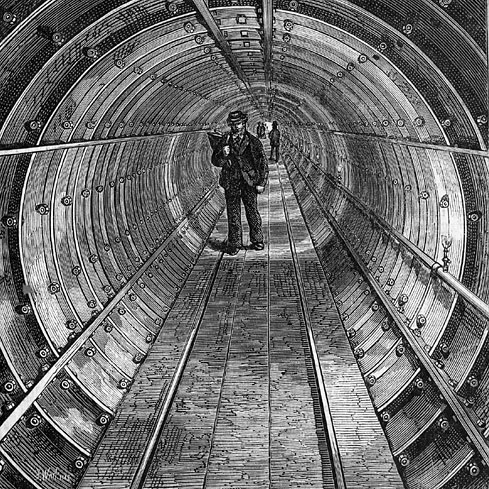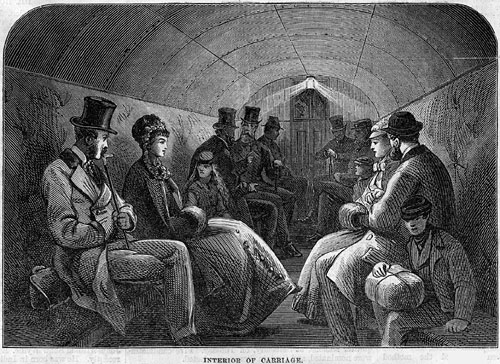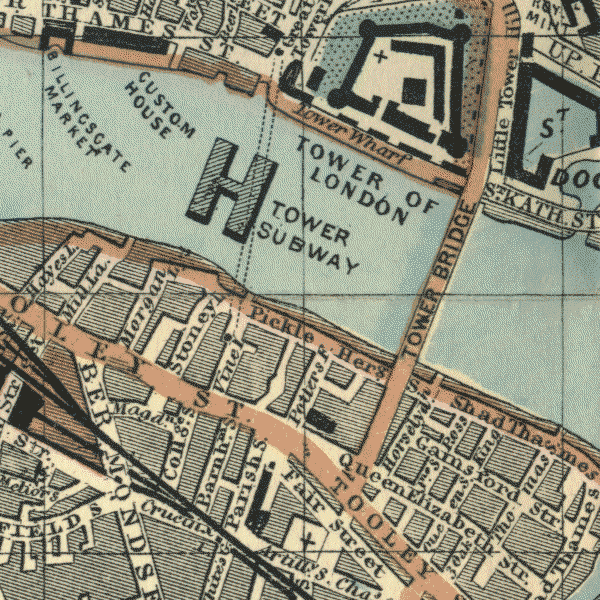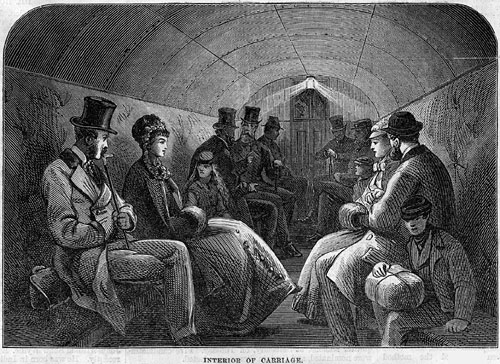
London Tower Subway in 1870
On August 2, 1870, the Tower Subway, the first tube railway in the world, was opened under the River Thames in London, England. Engineer James Henry Greathead used a tunnelling shield he modified from Barlow’s design to bore the 6-ft diameter tunnel near the Tower of London. It opened with steam operated lifts and a 12-seat carriage shuttled from end to end by wire rope powered by a steam engine.
The Idea of an Underground Line
In the 19th century, the city of London grew rapidly and the roads filled with cars and omnibuses at the same time. Talks about an underground railway probably began around 1830 and were highly supported by Charles Pearson, Solicitor to the City of London. He promoted several schemes and helped to set up the City Terminus Company in 1852 to build a railway from Farringdon to King’s Cross. However, the railway companies were not as interested and two years later, the Metropolitan Railway was given the permission to construct an underground line.

Interior of the Tower Subway carriage, from the Illustrated London News, 1870.
6 km Underground
Unfortunately, the company failed to raise the capital as the Crimean War was under way and therefore, the construction did not start until March 1860. The railway from Paddington to King’s Cross was mostly built using the “cut-and-cover” method, an often used method of the construction for shallow tunnels where a trench is excavated and roofed over with an overhead support system strong enough to carry the load of what is to be built above the tunnel. East of King’s Cross, the tunnels then lead to the River Fleet in an open cutting to the new meat market at Smithfield. The 6 km railway was opened on January 10, 1863 and used steam locomotives and wooden carriages.

Tower Subway on a map: Reynolds’ Shilling Map, 1895.
A Cylindrical Tunnel Shield
One year later, Peter William Barlow, an English civil engineer, associated with railways and bridges as well as the design of tunnels and the development of tunnelling techniques, patented a design for a cylindrical tunnelling shield. His method used a circular wrought iron or steel shield and filled up the gap between the tunnel lining with lime or cement to prevent settling of the ground above. Barlow suggested a network of tunnels with cars carrying up to 12 people and in 1868, the government decided to built a tunnel under the Thames between Great Tower Hill and Pickle Herring Stairs near Vine Street.
Under the River
Due to some delays, the actual work began in February 1869 and the under-river section was dug in fourteen weeks and the tunnel completed by December. The entrance shafts were fitted with steam-powered lifts for passengers and the tunnel was laid with 762 mm gauge railway track and a single car, carrying a maximum of 12 passengers, cable-hauled by two 4 horsepower stationary steam engines, one on each side of the river. The underground railway – and first tube railway – opened on August 2, 1870.

Interior of the car of the Tower Subway in 1870
Missing Economic Success
Unfortunately, the system was quite uneconomic and the company closed in December. As a consequence, the steam engines and rail car were removed. The passenger lifts were replaced with spiral staircases and gas lights were installed. The tunnel then opened to pedestrians and became a very popular way to cross the river with about 20,000 people a week. In 1888, the subway achieved notoriety very briefly when a man with a knife was seen in the tunnel at the time when Jack the Ripper was committing his infamous murders.[6]
The Tower Bridge
In 1894, the Tower Bridge opened a few hundred yards downriver. It was toll-free and caused a great drop in subway’s income. Three years later, Parliament passed an Act authorising the sale of the tunnel to the London Hydraulic Power Company and the subway closed to pedestrian traffic in 1898.
Oliver Green, ‘The Art of the Underground: 150 Years of Re-designing London‘,
Gresham College [5].
References and Further Reading:
- [1] Subterranea Britannica: Tower Subway
- [2] Wright, Laurence (24 July 2017). “James Henry Greathead and the London Underground”. Literator. 38 (1): 12.
- [3] Dickens, Charles, Jr. (1879). “Tower Subway”. Dickens’s Dictionary of London.
- [4] “Tower Subway – Part of the Secret London series”. Historic UK
- [5] Oliver Green, ‘The Art of the Underground: 150 Years of Re-designing London‘, Gresham College @ youtube
- [6] The Still Unsolved Case of Jack the Ripper, SciHi Blog
- [7] Tower Subway at Wikidata
- [8] Map of Tunnels underneath the River Thames, via Wikidata and DBpedia






Pingback: Whewell’s Gazette: Year 03, Vol. #51 | Whewell's Ghost